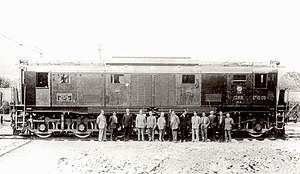SŽD series С И
| SŽD series С И (S I ) SŽD series С И М (S I M) |
|
|---|---|
|
С И 10-09
|
|
| Numbering: | С И ‑09 to ‑15 С И М ‑ 09 and ‑14 |
| Number: | 7 (С И ) 2 (С И , modification) |
| Manufacturer: | Tecnomasio Italiano Brown Boveri , Italy |
| Year of construction (s): | 1933–1934 (С И ) from 1952 (С И , conversion) |
| Retirement: | 1960-1979 |
| Axis formula : | Co 'Co' |
| Gauge : | 1524 mm |
| Length over coupling: | 16,500 mm |
| Height: | 4355 mm |
| Bogie axle base: | 2000 mm (inside), 2100 mm (outside) |
| Service mass: | 132 t - 142 t |
| Wheel set mass : | 22 t - 23.7 t |
| Top speed: | 65 km / h |
| Hourly output : | 2040 kW (С И ) 2400 kW (С И М) |
| Continuous output : | 1800 kW (С И ) 1860 kW (С И М) |
| Motor type: | GDTM-655 (С И ) ДПЭ-400А (С И М) |
| Power system : | 3 kV direct current |
| Number of traction motors: | 6th |
The locomotives of the class С И (German transcription S I ) of the Soviet Railways (SŽD) are wide-gauge electric locomotives . They were first designated as the series С И 10 (S I 10). Two locomotives of the series were converted to С И М (S I M).
Series С И (S I )
As the first long-distance railway line in the Soviet Union , the Chaschuri - Sestaponi section of the Poti – Baku line of the Transcaucasian Railway in the Georgian SSR was electrified in order to cope with the increasing transport services over the Surami Pass . The electrification was carried out with 3000 volts direct current . In the absence of experience with the construction of electric locomotives, the procurement of locomotives for this route abroad was planned. For this purpose, offers were obtained from the manufacturers AEG and Siemens-Schuckert (both Germany ) as well as Metropolitan Vickers ( United Kingdom ), General Electric ( USA ) and Tecnomasio Italiano Brown Boveri ( Italy ). General Electric was awarded the contract for eight and Tecnomasio Italiano Brown Boveri for seven locomotives. For the latter, the experience in building locomotives for 3000 volts direct current spoke, as this electricity system had previously been introduced in Italy. General Electric delivered eight locomotives of the С10 (S10) series, later designated as С (S) , to commence electrical operations in 1932 .
After locomotives from Soviet production were also available from 1932 with the series С С 11 (S S 11; later referred to as series С С (S S )), the first three locomotives from Tecnomasio Italiano Brown Boveri arrived in October 1933. As a continuation of the С10 series, they were given the numbers С И 10-09 to -11. The addition "И" (I) stands for the country of origin Italy. In terms of the main dimensions, they roughly matched the C10 series. The three-axle bogies, however, were constructed asymmetrically with a shortened wheelbase between the inner axles. In November 1933, 10-10 attempts were made to use С И in multiple traction, which were successful. Subsequently, all locomotives of the series С, С С and С И were equipped for multiple traction, but a mixed use of the series was not possible.
С И 10-09 to -11 had a service weight of 135 tons. After commissioning on the Suramipass it turned out that С И 10-09 to -11, as well as the series С10, missed the specified starting capacity by 1000 tons. With the С И 10-12 to -15 delivered in April 1934, the weight was increased to 142 tons by adding ballast. The weight of these locomotives was later reduced to 132 to 135 tons. The series designation was changed in the 1930s, the addition "10" was omitted, the final series designation was thus "С И ".
The С И were factory-fitted with a safety device that required certain pedals or buttons to be operated at least every 100 meters, otherwise braking was triggered. Since the С И were always manned by two train drivers, this safety device was usually deactivated.
The series С and С И remained based in Khashuri, which С proved to be operationally-compatible than the complicated structure С И . С И -08, -10 to -13 and -15 were retired from 1960 to 1965.
Series С И М (S I M)
С И -09 and -14 were also included in the modernization program of the С С series ; they were given the numbers С И М-09 and -14. The engines ДПЭ-400А (DPE-400A) of the ВЛ22М series were installed and the electrical structure was adapted to these locomotives, although the installation of a regenerative brake was dispensed with. The two С С М were retired in 1967 and 1979, respectively. None of the series С И and С И М have survived.
literature
- Vitaly Alexandrowitsch Rakow: Lokomotiwy otetschestvennych schelesnych dorog (1845-1955 gg.) . Transport, Moskva 1995, ISBN 5-277-00821-7 .
